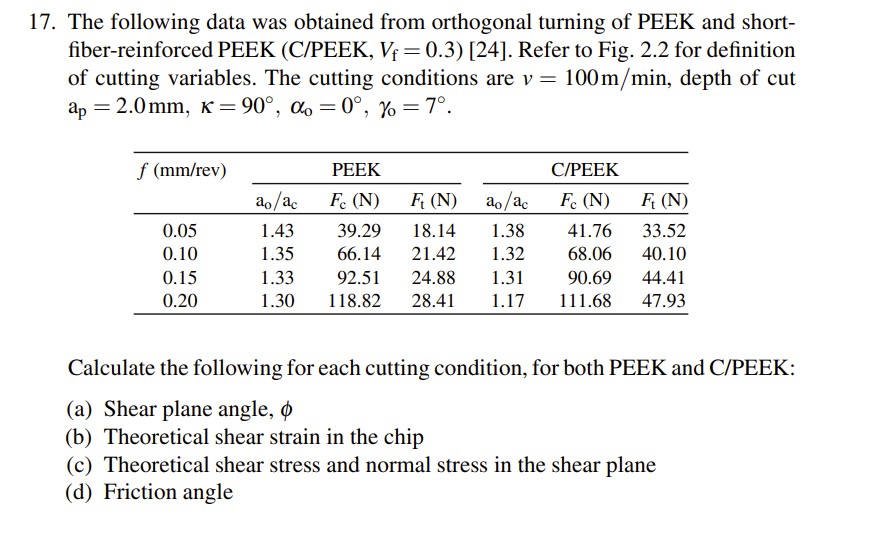Answered step by step
Verified Expert Solution
Question
1 Approved Answer
17. The following data was obtained from orthogonal turning of PEEK and short- fiber-reinforced PEEK (C/PEEK, V = 0.3) [24]. Refer to Fig. 2.2


17. The following data was obtained from orthogonal turning of PEEK and short- fiber-reinforced PEEK (C/PEEK, V = 0.3) [24]. Refer to Fig. 2.2 for definition of cutting variables. The cutting conditions are v = 100m/min, depth of cut ap = 2.0mm, k = 90, =0, Y = 7. f (mm/rev) PEEK C/PEEK ao/ac Fc (N) Ft (N) ao/ac Fc (N) F (N) 0.05 1.43 39.29 0.10 1.35 66.14 0.15 1.33 0.20 1.30 18.14 1.38 21.42 1.32 92.51 24.88 1.31 118.82 28.41 1.17 41.76 33.52 68.06 40.10 90.69 44.41 111.68 47.93 Calculate the following for each cutting condition, for both PEEK and C/PEEK: (a) Shear plane angle, (b) Theoretical shear strain in the chip (c) Theoretical shear stress and normal stress in the shear plane (d) Friction angle (e) Specific cutting energy, ps, specific shear energy, us, specific frictional energy, uf, and the difference [ps - (us +uf)]. Discuss the results. (f) Plot shear plane angle vs. (-) for both materials (g) Plot shear stress and normal stress in the shear plane vs. feed rate for both materials (h) Plot shear strain vs. feed rate for both materials (i) Using the results from (f), (h), and (i), discuss the applicability of the shear plane theory to the machining of PEEK and C-PEEK, highlighting the differences, if any, between the two materials.
Step by Step Solution
There are 3 Steps involved in it
Step: 1

Get Instant Access to Expert-Tailored Solutions
See step-by-step solutions with expert insights and AI powered tools for academic success
Step: 2

Step: 3

Ace Your Homework with AI
Get the answers you need in no time with our AI-driven, step-by-step assistance
Get Started


